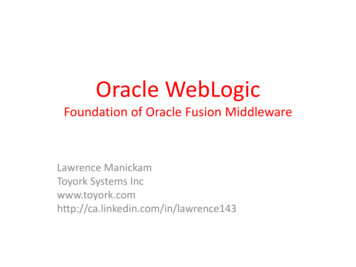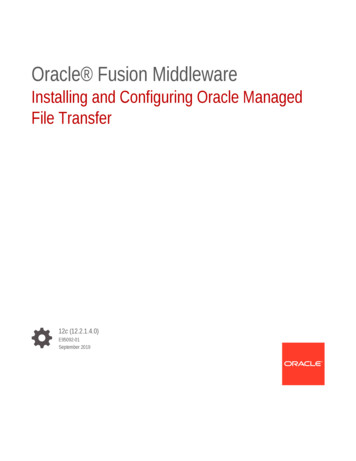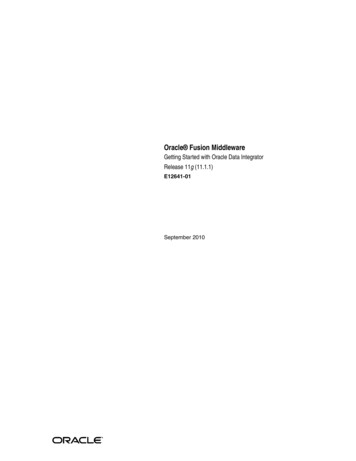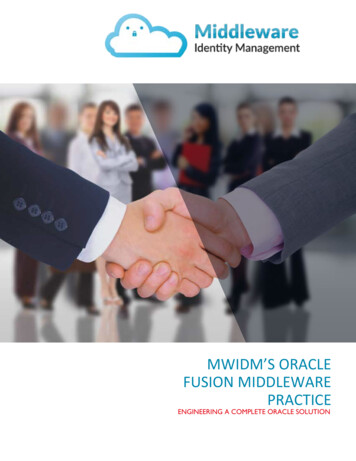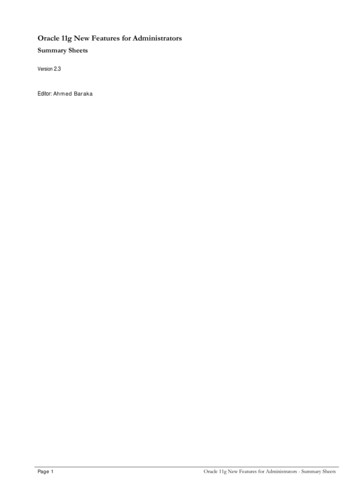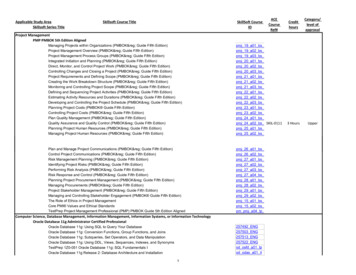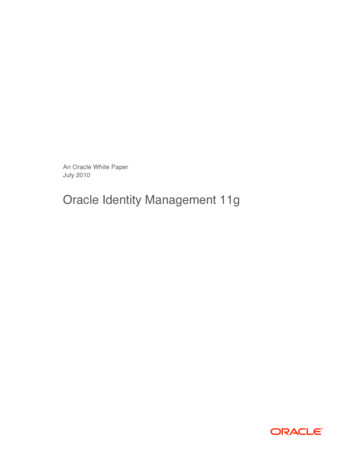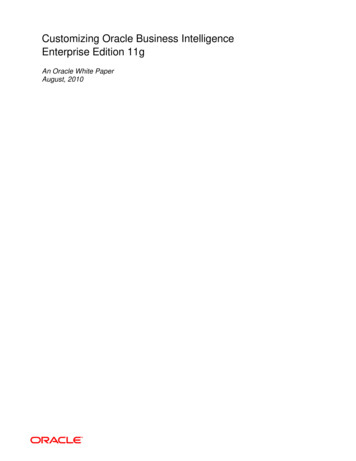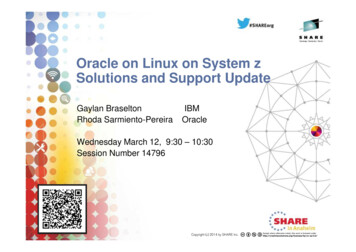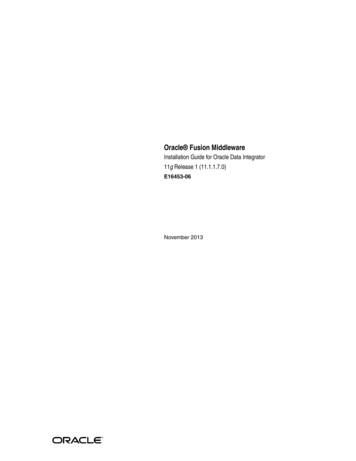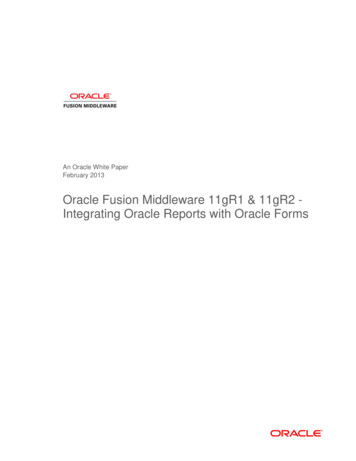
Transcription
An Oracle White PaperFebruary 2013Oracle Fusion Middleware 11gR1 & 11gR2 Integrating Oracle Reports with Oracle Forms
Oracle Fusion Middleware 11 - Integrating Oracle Reports with Oracle FormsIntroduction . 1Oracle Forms . 2Oracle Reports . 2The Oracle Forms RUN REPORT OBJECT Built-in . 3How to use RUN REPORT OBJECT . 4RUN REPORT OBJECT Examples . 4Using a Parameter List with RUN REPORT OBJECT . 7Calling Reports that Display a Parameter Form. 8Building a Procedure to Call Reports with Parameter Forms. 10The Oracle Forms WEB.SHOW DOCUMENT Built-in . 14WEB.SHOW DOCUMENT Syntax . 15Calling Reports using WEB.SHOW DOCUMENT . 15Summary. 17
Oracle Fusion Middleware 11 - Integrating Oracle Reports with Oracle FormsIntroductionThis paper discusses how to integrate Oracle Reports with Oracle Forms. After reading thiswhitepaper you will: Understand how to use the Oracle Forms RUN REPORT OBJECT built-in. Understand how a report is requested from an Oracle Forms application. Understand how to retrieve a completed report from Oracle Forms. Understand how to call reports which include a Reports parameter form. Understand how to call Oracle Reports from Oracle Forms when single sign-on (SSO) isenabled.This document is intended for individuals with a working knowledge of how to write OracleForms application code and understand the basic functionality in Oracle Forms and Reports onthe middle tier. Some understanding of HTTP Server and WebLogic Server functionality willalso be helpful. The sample code found within this document is provided for illustration andeducational purposes only. This code should not be used in production applications withoutfirst performing thorough and complete testing prior to use.1
Oracle Fusion Middleware 11 - Integrating Oracle Reports with Oracle FormsOracle FormsOracle Forms consists of two high level components: the Oracle Forms Developer design-timecomponent (aka the Forms Builder) and Oracle Fusion Middleware – Forms Services deployment (akaForms Runtime) component. For the purpose of this document, we will only be discussing thosefeatures and built-ins that are necessary to call a report from an Oracle Forms application.There are two Oracle Forms built-ins which are supported for calling Oracle Reports from OracleForms: RUN REPORT OBJECT WEB.SHOW DOCUMENTThese built-ins are explained in more detail within the Oracle Forms Builder Online help. Anexplanation of how these will be used to call Oracle Reports will be explained later in this paper. Moreinformation about deploying Oracle Forms can be found in the “Oracle Forms Deployment Guide”, whichis included in the Fusion Middleware 11g and 11gR2 documentation library on the Oracle TechnologyNetwork (OTN).If your application is being migrated from an earlier version of Oracle Forms, specifically version 6.xor older and the built-in RUN PRODUCT was used for Oracle Forms and Oracle Reports integrationand you are not able or willing to rewrite your code to use RUN REPORT OBJECT, please refer tothe documentation which discusses how to use the Forms Migration Assistant (FMA). Thisinformation can be found in the Fusion Middleware documentation library in the document titled,“Oracle Forms Upgrading Oracle Forms 6i to Oracle Forms 11g”.Oracle ReportsLike Oracle Forms, Oracle Reports consists of a primary design-time tool commonly referred to as theOracle Reports Builder and the Oracle Fusion Middleware – Reports Server component fordeployment. The deployment component within Fusion Middleware is referred to as Oracle ReportsServices or Server. Throughout this paper, the terms Reports Services and Reports Server are usedinterchangeably for the same component(s).More information about deploying Oracle Reports can be found in the Oracle Reports deploymentguide, titled “Publishing Reports with Oracle Reports Services” which is included in the Fusion Middleware11g and 11gR2 documentation library on OTN.2
Oracle Fusion Middleware 11 - Integrating Oracle Reports with Oracle FormsThe Oracle Forms RUN REPORT OBJECT Built-inThe most secure approach for calling Oracle Reports from Oracle Forms is to use theRUN REPORT OBJECT built-in. Because the user’s database connection is implicitly passed fromOracle Forms to Oracle Reports on the middle tier server, there is no risk of interception as whenpassed such information in a URL.In Oracle Forms Builder, to use the RUN REPORT OBJECT built-in, you will need to create a newReports object under the “Reports” node in the Object Navigator. Each Reports object has a logicalname, which is used within Forms to call the report from PL/SQL. You can optionally create a newReports object for each physical Reports file. One Reports object can also be used with many physicalReports files. The attributes of this object can be set in the Builder’s Property Palette at design-time orcan be set programmatically at runtime.Figure 1: Oracle Forms Object Navigator and Property Palette. Note that the “Reports” node includes the objects“MYREPORT1”, “REPTEST”, and “RP2RRO”. The physical Oracle Reports file referenced by the “MYREPORT1”object is defined as “reptest.rdf”. The Oracle Reports runtime settings below the “Reports” node in the PropertyPalette can be overwritten at runtime using SET REPORT OBJECT PROPERTY.3
Oracle Fusion Middleware 11 - Integrating Oracle Reports with Oracle FormsHow to use RUN REPORT OBJECTTo access a remote Reports Server using RUN REPORT OBJECT, Oracle Reports Services must beaccessible for the Report object in Oracle Forms. You can do this dynamically, using theSET REPORT OBJECT PROPERTY built-in, or statically, by entering the Oracle Reports Servername string into the Property Palette of the Report object.It is also important to note that Oracle Forms Services and Oracle Reports Services must reside withinthe same network subnet in order to work properly. If they are not, either the Oracle Reports NamingService or Oracle Reports Bridge can be used to overcome this particular configuration limitation.Refer to the “Publishing Reports with Oracle Reports Services” document previously mentioned for moreinformation about using the Reports Naming Service or a Bridge.RUN REPORT OBJECT ExamplesExample 1The following example runs a report using the Oracle Forms built-in RUN REPORT OBJECT.Note that at this point we are only requesting that a report be run. The data retrieved (i.e. reportoutput) will not be returned to the end-user at this point. This may be desirable in some cases. If so,set the DESTYPE to “FILE” in order to permanently store the file on the server for later use.In this example, the Reports object name is “MyReport1”. A user defined Reports parameter,“p deptno”, is passed using the value of the “dept.deptno” field. The parameter form is suppressedusing “paramform no”.DECLAREreport id Report Object;ReportServerJob VARCHAR2(254);BEGINreport id : find report object(‘MyReport1’);SET REPORT OBJECT PROPERTY(report id,REPORT COMM MODE,SYNCHRONOUS);SET REPORT OBJECT PROPERTY(report id,REPORT DESTYPE,CACHE);SET REPORT OBJECT PROPERTY(report id, REPORT DESFORMAT, ‘PDF’);SET REPORT OBJECT PROPERTY(report id,REPORT SERVER,’Repsrv’);SET REPORT OBJECT PROPERTY(report id,REPORT OTHER,’p deptno ‘ :Dept.Deptno ’ paramform no’);ReportServerJob : run report object(report id);END;Figure 2: General use of RUN REPORT OBJECT4
Oracle Fusion Middleware 11 - Integrating Oracle Reports with Oracle FormsExample 2The following example uses a synchronous call to RUN REPORT OBJECT to run a report. Itexpects the Reports object name, the Reports Server name, and the desired output format (PDF,HTML, HTMLCSS, etc) to be passed as parameters. It will also attempt to verify that the report wassuccessfully generated, and then display the results to the end user in a browser. The use of aprocedure such as this is recommended in cases where the application is likely to call out to Reportsfrom various places within the application.PROCEDURE RUN REPORT OBJECT PROC (vc reportoj Varchar2, vc reportserver varchar2, vc runformat varchar2) ISv report id Report Object;vc ReportServerJob VARCHAR2(100); /* unique id for each Report request */vc rep status VARCHAR2(100); /* status of the Report job */vjob id VARCHAR2(100); /* job id as number only string*/BEGIN/* Get a handle to the Report Object */v report id: FIND REPORT OBJECT(vc reportoj);/* Define the report output format and the name of the Reports Server as well as a user-defined parameter.Pass the department number from Forms to Reports. There is no need for a parameter form to be displayed,so paramform is set to “no”.*/SET REPORT OBJECT PROPERTY(v report id,REPORT DESFORMAT,vc runformat);SET REPORT OBJECT PROPERTY(v report id,REPORT DESTYPE,CACHE);SET REPORT OBJECT PROPERTY(v report id,REPORT COMM MODE,SYNCHRONOUS);SET REPORT OBJECT PROPERTY(v report id,REPORT SERVER,vc reportserver);SET REPORT OBJECT PROPERTY(v report id,REPORT OTHER,’p deptno ‘ :dept.deptno ’paramform no’);vc ReportServerJob: RUN REPORT OBJECT(v report id);vjob id : substr(vc ReportServerJob,instr(vc ReportServerJob,’ ’,-1) 1);/* Check the report status. Because this was a synchronous call ( REPORT COMM MODE),the status check will only return FINSIHED or an error. If COMM MODE is set to “asynchronous”, a timershould be used to periodically change the status of the running report before attempting to display it. */vc rep status : REPORT OBJECT STATUS(vc ReportServerJob);IF vc rep status ‘FINISHED’ THEN/* Call the Reports output to be displayed in the browser. The URL for relative addressing is validonly when the Reports Server resides on the same host as the Forms Server and is accessed via the same port.For accessing a remote Reports environment, you must use a fully qualified URL (i.e. http://hostname:port ) */WEB.SHOW DOCUMENT (‘/reports/rwservlet/getjobid’ vjob id ’?server ’ vc reportserver,’ blank’);ELSEmessage (‘Report failed with error message ‘ vc rep status);END IF;END;Figure 3: Using RUN REPORT OBJECT for integrating calls to Oracle Reports5
Oracle Fusion Middleware 11 - Integrating Oracle Reports with Oracle FormsIf you are upgrading from Oracle Forms or Oracle Reports 6i, when callingWEB.SHOW DOCUMENT you will need to modify the Reports job ID that is retrieved by theRUN REPORT OBJECT built-in so that the Reports Server name is not included.To use the procedure described above, you would pass the following information in a “When-ButtonPressed” trigger or other appropriate trigger:RUN REPORT OBJECT PROC ( ‘REPORT OBJECT’’ , ‘REPORT SERVER NAME’ ‘, ‘FORMAT’ )REPORT OBJECTForms Report object name containing the rdf filename for the ReportREPORT SERVER NAMEName of the Reports ServerFORMATAny of these formats: html html css pdf xml delimited rtfFigure 4: Parameters needed to use RUN REPORT OBJECT PROCA synchronous call to Reports will cause the user to wait while the report is processed on the server.For long-running Reports, it is best that the report be run asynchronously by setting theREPORT COMM MODE property to asynchronous and the REPORT EXECUTION MODE tobatch. For example:SET REPORT OBJECT PROPERTY(report id,REPORT EXECUTION MODE,BATCH);SET REPORT OBJECT PROPERTY(report id,REPORT COMM MODE,ASYNCHRONOUS);After calling RUN REPORT OBJECT, you must create a timer to run periodic checks on the currentREPORT OBJECT STATUS in a When-Timer-Expired trigger. After the report is generated, the“When-Timer-Expired” trigger calls the WEB.SHOW DOCUMENT built-in to display the Reportsoutput file, identified by its unique job ID, to the client’s browser.Here is an example of how the report status can be checked from the When-Timer-Expired trigger:(.)/* :global.vc ReportServerJob needs to be global because the information about the Report job id is sharedbetween the trigger code that starts the report and the trigger code When-Timer-Expired that checks the Report status. */vc rep status: REPORT OBJECT STATUS(:global.vc ReportServerJob);IF vc rep status ’FINISHED’ THENvjob id : substr(:global.vc ReportServerJob,length(reportserver) 2,length(:global.vc ReportServerJob));WEB.SHOW DOCUMENT (‘/reports/rwservlet/getjobid’ :vjob id '?server ’ vc reportserver,' blank');DELETE TIMER (timer id); -- Report done. No need to check any more.ELSIF vc rep status not in (‘RUNNING’,’OPENING REPORT’,’ENQUEUED’) THENmessage (vc rep status ’ Report output aborted’);DELETE TIMER (timer id); -- Report failed. No need to check any more.END IF;(.)Figure 5: Performing asynchronous call to Reports and checking its status from When-Timer-Expired6
Oracle Fusion Middleware 11 - Integrating Oracle Reports with Oracle FormsUsing a Parameter List with RUN REPORT OBJECTWith the RUN PRODUCT1 built-in (no longer supported for use in Oracle Forms), Reports systemparameters and user-defined parameters are passed in a parameter list. The same parameter lists can beused with RUN REPORT OBJECT, with the exception of the system parameters, which need to beset with the SET REPORT OBJECT PROPERTY built-in.REPORT EXECUTION MODEBATCH or RUNTIME2REPORT COMM MODESYNCHRONOUS ASYNCHRONOUSREPORT DESTYPEFILE PRINTER MAIL CACHE3REPORT DESFORMATHTML HTMLCSS PDF RTF XML DELIMITED SPREADSHEET2REPORT FILENAMEThe report filenameREPORT DESNAMEThe report destination nameREPORT SERVERThe Report Server nameFigure 6: List of system parameters used by RUN REPORT OBJECT.If your existing parameter list already contains definitions for system parameters, you may experienceerrors. To prevent such problems from occurring, modify the parameter list itself, either by removingthe entries for DESNAME and DESTYPE, or by addingDELETE PARAMETER ( parameter list ,’ name ‘);to your code before using SET REPORT OBJECT PROPERTY. The syntax for using parameterlists in RUN REPORT OBJECT is as follows:ReportServerJob : RUN REPORT OBJECT (report id,paramlist id);Note that having DESTYPE defined both in the parameter list and in SET REPORT OBJECTPROPERTIES should not prevent the module from compiling, but may prevent it from running.1. Using RUN PRODUCT to generate Reports output is not supported in Oracle Forms 9.0.4 and greater. Forms module containingintegrated calls to Reports using RUN PRODUCT will not compile. Refer to the Forms Upgrade Guide for information on how to usethe Forms Migration Assistance (FMA) or consider updating your code as discussed in this paper.2. Report Execution Mode is a client/ server feature and no longer used in Oracle Forms. However, setting the value to either BATCHor RUNTIME is required.3. Additional DESTYPE and DESFORMAT values can be found in the Oracle Reports deployment guide, titled “Publishing Reportswith Oracle Reports Services”7
Oracle Fusion Middleware 11 - Integrating Oracle Reports with Oracle FormsCalling Reports that Display a Parameter FormUsing the previous examples, a report’s parameter form will not work when called from RUNREPORT OBJECT because the ACTION attribute in the generated report HTML parameterform is empty. RUN REPORT OBJECT calls are sent directly to Oracle Reports on the server.Therefore, Oracle Reports cannot access the web environment to obtain the information required topopulate the action attribute when generating the HTML parameter form.The ACTION attribute is part of the standard HTML FORM tag that defines what to do whena user presses the submit button. The ACTION attribute in the Oracle Reports parameter formshould contain hidden runtime parameters that are required to process the request after the userpresses the submit button. Additional code is required to overcome this condition.Solving the Problem with “PFACTION”“PFACTION” is a command line parameter in Oracle Reports that can be used to add the hiddenruntime parameter to a report’s parameter form when calling Oracle Reports from Oracle Forms, usingRUN REPORT OBJECT. The syntax for the value “pfaction” parameter looks like this: request URL to rwservlet ? hidden encoded original url query string The “request URL to rwservlet” portion contains the protocol, the host name, the port, the OracleReports web context path and the Oracle Reports Servlet name. For etThe “encoded original url query string” portion is a duplicate of all Oracle Reports system andapplication parameters passed from Oracle Forms to Oracle Reports usingSET REPORT OBJECT PROPERTY, encoded in a URL. For example, these Reports commandline parameters,destype cache desformat htmlcss userid scott/tiger@orclwould be added as a value to the “pfaction” parameter like this,destype cache%20desformat htmlcss%20userid scott%2Ftiger%40orclIn order to call a report that contains a parameter form from Oracle Forms usingRUN REPORT OBJECT, do the following:1.Provide the protocol, the host name of the server, and the server port2.Provide the virtual path and name of the Oracle Reports Servlet3.URL encode the parameter value of the “pfaction” command parameterThe following Forms built-in will be used to pass the “pfaction” command from Oracle FormsServices to Reports:SET REPORT OBJECT PROPERTY (rep id,REPORT OTHER, ’pfaction .’);8
Oracle Fusion Middleware 11 - Integrating Oracle Reports with Oracle FormsNote that if you are using the REPORT OTHER built-in to pass application parameters to OracleReports, the application parameters must also be contained in the pfaction parameter.Using PL/SQL Functions to Encode URL ParametersBecause the “pfaction” parameter is added as an ACTION parameter to the Oracle Reports HTMLparameter form, it is important to ensure that no un-encoded characters are included or errors mayresult. One example that may cause problems when embedded in a URL is a blank (space). Therefore,most developers URL-encode blank as “%20”. The PL/SQL function “ENCODE”, as listed below, isan example that encodes the following characters: “;”, “/ ”, ”?”, ”:”, ”@”, ” ”, ” ”, ”,” and “ “(semicolon, forward slash, question mark, colon, at, plus sign, dollar sign, comma, and blank space).FUNCTION ENCODE (URL PARAMS IN Varchar2) RETURN VARCHAR2 ISv urlVARCHAR2(2000) : URL PARAMS IN; -- Url stringv url tempVARCHAR2(4000) : ‘‘; -- Temp URL stringv aVARCHAR2(10); -- conversion variablev bVARCHAR2(10); -- conversion variablecCHAR;iNUMBER(10);BEGINFOR i IN 1.LENGTH(v url) LOOPc: substr(v url,i,1);IF c in (‘;’, ‘/’,’?’,’:’,’@’,’ ’,’ ’,’,’,’ ‘) THENv a : ltrim(to char(trunc(ascii(substr(v url,i,1))/16)));IF v a ‘10’ THEN v a : ‘A’;ELSIF v a ‘11’ THEN v a : ‘B’;ELSIF v a ‘12’ THEN v a : ‘C’;ELSIF v a ‘13’ THEN v a : ‘D’;ELSIF v a ‘14’ THEN v a : ‘E’;ELSIF v a ‘15’ THEN v a : ‘F’;END IF;v b : ltrim(to char(mod(ascii(substr(v url,i,1)),16)));IF v b ‘10’ THEN v b : ‘A’;ELSIF v b ‘11’ THEN v b : ‘B’;ELSIF v b ‘12’ THEN v b : ‘C’;ELSIF v b ‘13’ THEN v b : ‘D’;ELSIF v b ‘14’ THEN v b : ‘E’;ELSIF v b ‘15’ THEN v b : ‘F’;END IF;v url temp : v url temp ’%’ v a v b;ELSEv url temp : v url temp c;END IF;END LOOP;return v url temp;END;Figure 7: PL/SQL function to URL-encode strings9
Oracle Fusion Middleware 11 - Integrating Oracle Reports with Oracle FormsBuilding a Procedure to Call Reports with Parameter FormsCalling Oracle Reports using RUN REPORT OBJECT is best handled by a generic PL/SQLprocedure in Forms. To successfully call a report from Oracle Forms, the following minimuminformation needs to be passed to the Reports pfaction command: Desformat, to determine the Reports output format Destype, to determine the output device, (printer or cache) Userid, to connect Reports to the database Reports file name, to specify the Reports module to be executed Paramform yes, to enable the Reports parameter form to be shown in the client browserThe generic PL/SQL procedure handling calls to Oracle Reports using RUN REPORT OBJECTrequires a Reports Object node to be created in Forms as mentioned earlier in this paper. One ReportsObject node can be used to run any Report.The following arguments are expected by this procedure:report idThe Report Object as obtained by a call toFIND REPORT OBJECT(‘ name ‘);report server nameThe name of the Reports Server, for example: “repserv11g”report formatHTML, HTMLCSS, PDF, RTF, XML4report destype nameCACHE, FILE, MAIL, PRINTER4report file nameThe Reports source module with or without extensionreport other paramAny other parameter like paramform or custom application parameters. If printingto FILE or MAIL, desname needs to be provided as ‘otherparam’report servletThe virtual path for the Reports Servlet. The virtual path, if not specified asrelative, must contain the protocol (http or https), the host name, the port, theReports context root (i.e. /reports) and the name of the Servlet (i.e. rwservlet).Figure 8: Parameters passed in by the generic procedure example4. Additional DESTYPE and DESFORMAT values can be found in the Oracle Reports deployment guide, titled “Publishing Reportswith Oracle Reports Services”10
Oracle Fusion Middleware 11 - Integrating Oracle Reports with Oracle FormsPROCEDURE RUN REPORT OBJECT PROC (report idREPORT OBJECT,report server nameVARCHAR2,report formatVARCHAR2,report destype name NUMBER,report file nameVARCHAR2,report otherparamVARCHAR2,reports servletVARCHAR2) ISreport messageVARCHAR2(100) : ‘‘;rep statusVARCHAR2(100) : ‘‘;vjob idVARCHAR2(4000) : ‘‘;hidden actionVARCHAR2(2000) : ‘‘;v report otherVARCHAR2(4000) : ‘‘;inumber (5);cchar;c oldchar;c newchar;BEGIN-- Set up Reports runtime parametersSET REPORT OBJECT PROPERTY(report id,REPORT COMM MODE,SYNCHRONOUS);SET REPORT OBJECT PROPERTY(report id,REPORT FILENAME,report file name);SET REPORT OBJECT PROPERTY(report id,REPORT SERVER,report server name);SET REPORT OBJECT PROPERTY(report id,REPORT DESTYPE,report destype name);SET REPORT OBJECT PROPERTY(report id,REPORT DESFORMAT,report format);-- Set up string for pfaction parameterhidden action : hidden action ’&report ‘ GET REPORT OBJECT PROPERTY(report id,REPORT FILENAME);hidden action : hidden action ’&destype ‘ GET REPORT OBJECT PROPERTY(report id,REPORT DESTYPE);hidden action : hidden action ’&desformat ‘ GET REPORT OBJECT PROPERTY (report id,REPORT DESFORMAT);-- Note that the username and password information will be visible within the html source-- of the parameter form. This can be prevented by enabling single sign-on.IF get application property (sso userid) IS NULL Then-- No SSO userhidden action : hidden action ’&userid ‘ get application property(username) ’/’ get application property(password) ’@’ get application property(connect string);ELSE-- SSO user identifiedhidden action : hidden action ‘&ssoconn ‘ get application property(config);End if;-- The Reports “other” parameters are passed as key value pairs. For example: “key1 value1 key2 value2 ”Figure 9: Generic procedure to call reports which use parameter forms. (part 1 of 2)11
Oracle Fusion Middleware 11 - Integrating Oracle Reports with Oracle Forms-- The following loop replaces the delimited blank with an “&” used on the web. This replacement only works for-- values that don’t include blanks themselves. If this is a requirement, then you need to customize this code accordingly.-- c old is initialized with a dummy valuec old : ’@’;FOR i IN 1.LENGTH(report otherparam) LOOPc new: substr(report otherparam,i,1);IF (c new ‘ ‘) THENc: ‘&’;ELSEc: c new;END IF;-- eliminate multiple blanksIF (c old ‘ ‘ and c new ‘ ‘) THENnull;ELSEv report other : v report other c;END IF;-- save current value as old valuec old : c new;END LOOP;hidden action : hidden action ’&’ v report other;--“reports servlet” contains the path to the Reports Servlet-- Example 1:--Forms and Reports are on the same host and accessed using the same port (e.g. 8888)--reports servlet : ‘/reports/rwservlet’-- Example 2:--Forms and Reports are on separate hosts and/or are accessed using a different port (e.g. 9001 & 9002)--reports servlet : ‘http://host:port/reports/rwservlet’hidden action : reports servlet ’? hidden server ‘ report server name encode(hidden action);SET REPORT OBJECT PROPERTY (report id,REPORT OTHER,’pfaction ‘ hidden action ’ ‘ report otherparam);-- call Reportsreport message : run report object(report id);rep status : report object status(report message);IF rep status ‘FINISHED’ THENvjob id : substr(report message,length(report server name) 2,length(report message));WEB.SHOW DOCUMENT(reports servlet ’/getjobid’ vjob id ’?server ‘ report server name,’ blank’);ELSE-- handle errors heremessage(rep status);END IF;END;Figure 10: Generic procedure to call reports which use parameter forms. (part 2 of 2)12
Oracle Fusion Middleware 11 - Integrating Oracle Reports with Oracle FormsExamples of How to Call the Generic ProcedureAssuming that a Reports Object “reptest” exists in the Forms module, the following code can be usedin a WHEN-BUTTON-PRESSED trigger to execute a Report that has a parameter form.The generic PL/SQL procedure requires the Reports Object to be passed as an argument. The ReportsObject of a given Reports Object name can be obtained using the FIND REPORT OBJECT built-in.Because it is assumed that the server running Forms Services also hosts the Reports Services, no hostname needs to be passed as an argument for the Reports Servlet path variable. Instead ‘/reports/rwservlet’ can be used as a relative path. Paramform yes makes Reports first expose its parameterform. The parameter form will always display in HTML even if the Reports destination format is PDF.(.)-- Find the id of the Reports Object in Formsreport id: FIND REPORT OBJECT(‘reptest’);-- Call the generic PL/SQL procedure to run the Reports-- Remember that, in this example the value of reports server can only be a-- relative path if the same host and port are used to access both Forms and Reports.RUN REPORT OBJECT PROC( report T’,‘paramform yes’,‘/reports/rwservlet’);(.)Figure 10: Generic procedure to call reports which use parameter forms.In the example below, an additional parameter is passed to Reports. Note that the delimiter is a blankcharacter between the first key-value pair and the second.(.)-- Find the id of the Reports Object in Formsreport id: FIND REPORT OBJECT(‘reptest’);-- Call the generic PL/SQL procedure to run the Reports-- Remember that, in this example the value of reports server can only be a-- relative path if the same host and port are used to access both Forms and Reports.RUN REPORT OBJECT PROC( report T’,‘paramform no p deptno 10’,‘/reports/rwservlet’);(.)Figure 11: Calling a report that has no parameter form, but requires p deptno to be passed as a runtime parameter.13
Oracle Fusion Middleware 11 - Integrating Oracle Reports with Oracle FormsIf the Reports Services runs on a different machine or with a different port number than FormsServices, you’ll need to provide the fully qualified URL for the Reports Servlet. Note that theseexamples work with the PL/SQL procedure RUN REPORT OBJECT PROC, which is explainedearlier in this document. You are free to create your own PL/SQL code to handle the “pfactions”command in your applications.(.)-- Find the id of the Reports Object in Formsreport id: FIND REPORT OBJECT(‘reptest’);-- Call the generic PL/SQL procedure to run the Reports-- Remember that, in this example the value of reports server can only be a-- relative path if the same host and port are used to access both Forms and Reports.RUN REPORT OBJECT PROC( report T’,‘paramform ’);(.)Figure 12: Calling a report which has a parameter form, but whose Reports Servlet listens on a different port (or host).The Oracle Forms WEB.SHOW DOCUMENT Built-inUse the WEB.SHOW DOCUMENT built-in to access any web site (URL) from a Forms application.This built-in passes the provided URL to the client’s default web browser. Oracle Forms has nocontrol over the receiving browser. The built-in simply passes the URL to the browser. It isrecommended that only web protocols be used with this built-in although it is possible to access somelocal content. For example, this built-in works best with protocols like HTTP, HTTPS, FTP, etc. Youcan use others such as, MAIL, MAILTO, FILE, but these are not recommended. These others shouldbe accessed using other means such as WebUtil. Refer to the Forms Builder Online Help forinformation about WebUtil.14
Oracle Fusion Middleware 11 - Integrating Oracle Reports with Oracle FormsWEB.SHOW DOCUMENT SyntaxWEB.SHOW DOCUMENT (URL, DESTINATION);URLThe URL is passed as a string (‘http://www.oracle.com’), in a variable, or as acombination of both. If the addressed web page is located on the same host asthe Forms Server, a relative path could be used (‘/virtual path/’).DESTINATION (aka TARGET)Definition of the target where the addressed web page should be displayed.Values must be single-quoted and lower case.blank (default)Loads the document into a new, unnamed top-level window.‘windowName’. Displays the document in a window namedwindowName. This window is created if necessary.selfLoads the document into the same frame or window as the sourceparentLoad the document into the parent window or frameset containing thehypertext reference. If
is included in the Fusion Middleware 11g and 11gR2 documentation library on the Oracle Technology Network (OTN). If your application is being migrated from an earlier version of Oracle Forms, specifically version 6.x or older and the built-in RUN_PRODUCT was used for Oracle Forms and Oracle Reports integration
